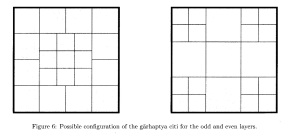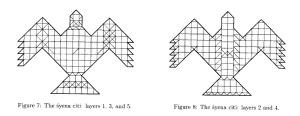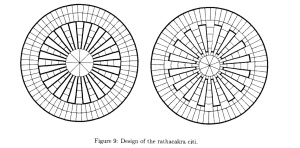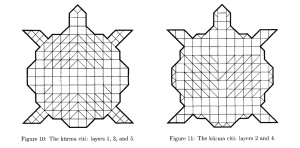In the previous two posts [1, 2] in this series, a brief introduction of Athirathram, Syenachiti and detailed study describing references from history to Athirathram and Syenachiti was done. In this concluding piece, a study science associated with Yajnas in general will be dealt with.
It has been explained on several occasions that ancients Hindus knew a lot about various sciences. There are several references clearly describing economics, politics, probability, geometry, trigonometry, mathematics of numbers, chemical sciences and several other fields. Yajnas are probably the best places to explore how vedas describe laws, rules and assumptions made by the ancient Hindus while exploring these sciences. For instance, many feel that Bhagavata Purana has metaphorical explanation of concepts like Time Dilation. Some feel that Vedas themselves were divided into Shakas by Veda Vyasa using principles of Graph Theory. Mathematicians also worked on mathematical analysis of Sanskrit. Yajna is no exception. Thus, Athirathram is no exception. Specifically, two areas are worth talking about.
- What is the cumulative effect of a Yajna?
- What is Mathematics involved in chiti construction?
What is the cumulative effect of a Yajna?
Dr. V P N Nampoori is a Namboothiri himself and is fascinated by Athirathram. With his team from Cochin University of Science and Technology, during Panjal Athirathram, he conducted several scientific experiments.
In a conversation with him, he said “we have set up our experimental setup and a lab nearby and we are trying to evaluate microbial growth at various points at radially increasing distances from the site of Yajna”. The idea according to him is to identify how the environment is getting affected by the performance of this Yajna. When asked what are the areas that could be looked at, he said “an important aspect of Yajna is mantra recitation which is basically acoustics. One interesting experiment would be to do signal processing on the recorded sound to identify frequencies and harmonics. We have recently developed a method to deduce harmonics and main frequencies from a signal. We are exploring the option of using data collected here as data set for our theory”. Also, Dr. Nampoori feels that many areas of science are left out because people wave off Vedic rituals as superstition. Dr. Nampoori explained “We should not ignore these rituals as superstition. It is important to understand the effects. It may be superstition but we should try to understand what kind of effects such vedic rituals have”.
On the most asked question on Yajna of how is rain after Yajna explained, Dr. Nampoori said “the particulate matter which is lighter than air could be reason for condensation of moisture in air finally culminating in rain at the end of a Yajna. This is one hypothesis we are exploring. We hope experimental data collected here would be able to corroborate this hypothesis”.
Dr. Nampoori was not alone at Panjal Athirathram. He was joined by a team from Indian Institute of Astro Physics, Bangalore exploring particle nature around Yagasala. Another team from Andhra University, Visakhapatnam collected data to explore chemistry behind Athirathram. Dr. Nampoori explained that AU was particularly interested in data regarding Carbondioxide, Carbonmonoxide in and around Panjal before and after Athirathram. To this extent, these teams also collected soil samples at various points around Yagasala.
This genuine interest suggests that there is general interest among scientific community to understand Vedic Rituals and their effects on environment. When asked when experimental data would be analyzed and observations would be published, he said “we are currently planning to publish our observations by May 15 but it may longer”. According to Miss Sudha, a Biomedical Sciences PhD candidate at Nagarjuna University, Guntur, the main purpose of using Soma plant in this ritual is to be able to withstand various effects of mantra recitation and heat produced during Yajna. Miss Sudha also asserted that the Soma plant has at least 108 different medicinal uses as documented in various Samhitas including Acharya Nagarjuna’s work.
Apart from the analyses and hypotheses provided by some researchers and scholars of sciences, a Syenachiti structure found at Uttaranchal reveals interesting details. This paper analyzing the bricks found at Purola by ASI indicates that bricks used were burnt at temperatures reaching 900-950 degrees centegrade. The paper also asserts that the bricks were not made at such high temperatures but were later burnt at high temperatures. The paper concludes that
Investigations on a fired brick sample from an ancient altar structure reveal that technology of making fired clay building-material was adequately known during the period. Further, physical and mineralogical examination of briquette samples revealed that partial deterioration of fired body resulted due to physical factors like river flow, seismic activity, temperature fluctuations, etc. and partly due to chemical factors involving rain-water leaching, wetting and drying cycles during its existence in the altar structure.
Thus fundamentally, brick making was a mature technology at least 2000 years ago, ancient Indians should have understood best practices in construction engineering too. Ancient temples stand as testimony to this.
What is Mathematics involved in chiti construction?
The most fascinating aspect of Yajna, as described in part 1 of this series is perhaps Chitis (in both mahavedi and agnihotra sala) and its construction. Chiti comes from the sanskrit root Chit. Unfortunately, foreigners relate chiti to “pile”, but apte relates chiti to “chit”. A Chiti is made up of a specific structure. As mentioned in part 1 of this series, several types of chitis are used. Lot of research has already been done on Mathematics involved in chiti construction. All the structures known to Hindus have been explained in a great detail in Srouta Sutras detailed in Kalpa Sutras.
In the papers published so far, researchers quote several sutras as sources for chiti construction process. It is thus logical that chiti construction is distributed across sutras. Another curious question is
Could it be that there was a formal conference during which these sutras were drafted or direction of documentation of these sutras happened?
Foreign historians place each author of Kalpa Sutra books at various points in history. But the similarities present in these sutras is a very important aspect which cannot be ignored. Whatever be the case with dating of Kalpa Sutras, one cannot contest the fact that the chitis are described in these sutras in excruciating detail and often, mathematical precision reaches upto 10 or more decimal points. To quote John F Price in this paper,
For me, there are three outstanding features of the Sulba Sotras: the wholeness and consistency of their geometrical results and constructions, the elegance and beauty of the citis, and the indication that the Sutras have a much deeper purpose
John F Price also explains that all Kalpa Sutras have a common format.
The Sulba Sutras form part of the Kalpa Sltras which in turn are a part of the Vedangas. There are four main Sulba SUtras, the Baudhayana. the Apastamba, the Manava, and the Katvavana, and a number of smaller ones. One of the meanings of Sulba is “string, cord or rope.” The general formats of the main Sulba Sltras are the same; each starts with sections on geometrical and arithmetical constructions and ends rvith details of how to build citis which, for the moment, u’e interpret as ceremonial platforms or altars. The measurements for the geometrical constructions are performed by drawing arcs with different radii and centers using a cord or Sulba.
This quote from a Mathematics researcher actually strengthens our reasons to think in the direction of question posed above. There is a definite possibility that writers of sutras were contemporaries or at best 2-3 generations apart (generation being 2-3 decades). It is also possible that there was a formal mechanism to document these observations. It is common knowledge of every Hindu that all sutras are observations from Vedas. So another area of research would be to identify the sources of Sutras in Vedas so that any sutras which were lost in time could be rewritten.
From text and commentaries on Sutras, John F Price gives schematics of different chitis.
Garhapatya Chiti
Garhapatya Chiti, like other complex structures, has clearly defined even and odd layer structures.
The most important aspect of Garhapatya chiti is extensive use of Square shape. John F Price derives how sutras describe construction of a square. To quote him:
From verses I, 22-28 of the Baudhayana Sulba Sutra (BSS), the procedure is to start with a pracr and a center point (line EPW in Figure 1) and, by describing circles with certain centers and radii, construct a square ABC D in which ,E and lV are the midpoints of AB and C D.
The specific verses John F Price is referring to could be found in Baudhayana Sulba Sutra.
Syena Chiti
Syena Chiti is described by John F Price as shown in this picture.
There is a difference in schematic as described by John F Price and S N Sen and AK Bag in their commentaries. S N Sen and A K Bag also provide numbering on each brick used for chiti. This is an important aspect as in Athirathram 2011 also similar numbering was seen.
Japanese researcher Michio Yano attended Athirathram 2011. A professor of Sanskrit and Indian Cultural History at Kyoto Sangyo university calls himself a Sanskrit Addict and is looking for Mathematical details of Chiti construction.
Michio Yano, Professor of Sanskrit and Indian Cultural History at Japan’s Kyoto Sangyo University, is attending Athirathram, a 12-day Vedic ritual being held at Panjal, near here.
He says that he has collected at Athirathram details about ancient mathematics that would go into his new book, ‘Inspiration of Indian Mathematics’.
Notice the use of Shianachitti instead of Syena Chiti. This is another problem with foreigners documenting our history and our ritual process. In digital era, such inconsistencies in sanskrit words written in English makes it difficult to search for information. It is thus necessary to create a benchmark in Sankrit English Transliteration and ensure it is followed at least in India. This could be a very good project if National Informatics can do it, with proper motivation and funding by Government of India. However, it is quite clear in recent times that GoI is busy with several other “projects”.
According to some who interacted with Michio Yano at Panjal, he believes Chiti construction and Avahanam process involved in 12 Pravargya and Upasath rites has an algorithmic approach to it and has to be understood to see if similar patterns exist in other aspects of Hindu Culutre.
Syena Chiti is described in Boudhayana Sulba Sutra in Second Section. First section describes construction of square, circle etc. Second section describes construction of Garhapatya chiti and subsequent sections describe construction of other complex chitis.
Ratha Chakra Chiti
John F Price gives the following schematic of Ratha Chakra Chiti in his paper.
Ratha Chakra chiti description is fairly similar according to others like S N Sen and A K Bag. This chiti has an interesting mathematical detail according to John F Price.
The initial calculations for determining the different parts of the ‘*’heel are in terms of square bricks each of area 1/30 square purusas. Since the final area is required to be 7.5 square purusas, the number of bricks is 7.5 x 30 : 225. The nave of the wheel consists of 16 of these bricks. the spokes 64 and the rim 145, making 225 in all. The spaces between the spokes are equal in area to the spokes and so, if these spaces are included,the overall area is 225 + 64 : 289 bricks.
Notice that overall area is curiously comes from a Pythagorean set {8,15,17}.
Kurma Chiti
John F Price describes Kurma Chiti also in his work. The figure explains
Evidently, Kurma Chiti is much more complex compared to Syena Chiti or Ratha Chakra Chiti. S N Sen and A K Bag give a description of this chiti with type of brick used in their paper. The book is not available online but come snippets have been captured in this document. This chiti used 6 types of bricks. Area of this structure should be 120 chathurthis according to the authors.
Other chitis
Boudhayana Sulba Sutras explain other structures also like Prauga chiti, Kanka chiti, Drona chiti etc. It would make a very interesting project for Secondary and Higher Secondary students across India to understand all these structures and come up with schematics and models of chiti construction. Since the geometry involved starts with very basic structures like Square, Circle, Sector, Trapezium, Rectangle, Parallelogram etc., secondary and higher secondary students, if equipped with Sanskrit knowledge would interpret data available in Sulba Sutras in great detail.
Construction Sequence of Chitis
Subhash Kak explains that there are as many as 95 chitis which are built in sequence. The obvious questions are
Why did the authors of Sulba Sutras propose this sequence?
What is the importance of this sequence?
There are a few questions that would be great points of research. Also, Sutras also describe a very detailed structure for odd and even layers. They are more like Figure and Ground. On this point, another question that comes up is
Whether number sequences described in Rudram relate to Chiti construction and layers involved?
Conclusion
In Truthiyadhyaya (3rd chapter) of Bhagavadgita, Sri Krishna explains to Arjuna on why Yajnas have to be done.
अन्नाद्भवन्ति भूतानि पर्जन्याद् अन्नसंभवः |
यज्ञाद्भवति पर्जन्यो यज्ञः कर्म समुद्भवः ||
Meaning
All living bodies subsist on food grains, which are produced from rains. Rains are produced by performance of yajna [sacrifice], and yajna is born of prescribed duties.
Sri Krishna explains this in third adhyaya which fundamentally gives an explanation of Karma Yoga. Panjal Athirathram thus becomes the Dharma Karyam of the year. Performing of Yajnas is a Hindu’s duty precisely because it results in rain which provides food. Thus, Yajna is a technological process at least by the time of Krishna.
The million dollar question on 15th of April at Panjal was whether or not it would rain. On 15th April 2011, at 9:30, just as Athirathram was about to conclude, Panjal experience heavy downpour for about 30 minutes. The same happened in 1975 according to media archives. More than what happened, people’s reaction is something to be taken into account. At around 9:30, Surekha Pillai tweeted live from Panjal:
there’s thunderstorm and people are cheering and clapping.
This is indication of the faith that people have in Yajna procedures. So, to the question of whether Vedic Ritual is a scientific experiment, well it seems to be so because it did rain during properly performed Yajnas.
Apart from being our duty, Yajnas also become part of Hindu culture i.e., India’s culture. Sutras which document everything related to Yajnas are clearly products of extensive research done on Vedas.
Several questions still remain
Are the detailed notes in Sutras annotated texts of Vedas and Upanishads?
Did civilization at the time of Rama know sutras? If so, were Sutra writers contemporaries or ancestors of the civilization of Rama’s time?
Altars seen in Indus Valley indicate that they are Grahapatya chitis, which are for domestic use. Does this mean Sutra writers were before or during IVC or does it mean IVC were vedic and Sutra writers wrote annotated texts to Vedas?
Given that IVC cities were very sophisticated in urban planning, what are the odds that IVC were using all the complex structures for chitis described in sutras?
Why is there such a great detail on construction sequence of Chitis? Is it only to preserve tradition with hard and fast rules or does it have a greater significance?
Each author of the four major Vedangas – Apasthamba, Boudhayana, Katyayana and Manava – wrote Sutras in four parts : Grihya, Sulba, Srouta and Dharma. Each set of four Sutras are definitely companion works and all the 16 should be put in perspective to get a bigger picture on how a common Hindu household would have been during the time of these works, as all these four describe all duties of a common Hindu. The similarities and cross referencing, if any must also be used while dating these writers because heavy citation/similarities across all 16 works would indicate that the writers were contemporaries and further, these works could have been the result of a formal convention on Vedic Studies of ancient times.
It is our Dharma to do our own research and put all these works in perspective with our Smritis and Puranas because these documents would provide a perspective on the life and times of our ancestors. It does not mean that foreign research should be discouraged. It only means that we should write our own history. If left to foreigners who do not understand terms like Dharma, Karma and other such important aspects of a common Hindu’s life, we would be left with inexplicable theories like Aryan Invasion.
To end this series, I leave you with this rousing climax of the movie Paithrukam. Son of a Namboothiri rejects Athirathram as superstition and opposes his father publicly. His father continues despite such opposition calling it his Karma. What happened when Athirathram was concluded?
Namboothiri walks off peacefully after completing his Karma without any regard to the result of his Karma. Namboothiri’s son questions people on why they follow such supersititions when it is clear that there is no use owing to clear skies and least possibility of rain. And lo! it rains! It rains heavily. Namboothiri heads back to his house and sacrifices life as he considers his Karma complete. His son, who opposed him till then, experiences major transformation and years later gets ready to perform Athirathram again. This is Karma. Performing our Karmas is our Dharma. Paithrukam, at level would look like a biased screen play but the message within is to follow Dharma by performing prescribed Karma. To add to all this, the screen play writers of the movie are Kaloor Dennis and George Vettam. Future of India lies in plurality where religions which originate elsewhere appreciating nuances of Hindu religion like Dharma and Karma.
धर्मो रक्षित रक्षतः |
References:
- Sanskrit texts of Vedangas [Link]
- The Ramayanam from http://www.valmikiramayan.net
- Sanskrit Text of Mahabharatam [Link]
- The Mahabharata – Original Translations by Kisari Mohan Ganguly
- Notes on fire altars in IVC sites [Link]
- Somasushma Blog [Link]
- ASI 1997-98 Review [Link]
- ASI 1988-89 Review [Link]
- ASI 1957 – 1958 Review [Link]
- Physical and mineralogical evaluation of a brick sample from an ancient altar structure in Garhwal Himalayan region [Link]
- Mathematics in Ancient India by Amartya Kumar Dutta [Link]
- http://www.athirathram2011.com
- http://www.athirathram.org
- http://sandeepvarma.com/category/panjal-athirathram-2011/
Acknowledgements:
- Surekha Pillai for live tweeting from Panjal and for making that memorable 20 minute conversation with Dr. Nampoori possible
- Sandeep Varma for some excellent ground work done before and during Athirathram, helping novices like me to understand Athirathram
- Dr. Narayanan, an independent management consultant enthusiastic about Yajnas for a long time
- Dr. Swami, a Ayurvedic Doctor in Kerala
- Dr. V P N Nampoori, professor and researcher at Cochin University of Science and Technology
- Twitter user @NR_Tatvamasi for some excellent offline discussion in prying out links from Google on various topics about Athirathram and other Soma Yajnas
- Twitter user @emanin for offline help on various occasions
- Maharshi University, Gayatrimantram.com and Astrojyoti.com for sanskrit texts of epics and Sutras
- And last but not least, Google 🙂
Notes:
- All pictures taken at Panjal Athirathram Site during Day 5 and Day 6 of Yajnam are available on Picasa (Audio files are playable on latest VLC)
- All digital documents used in this series have been uploaded for download at 4shared
Concluded





[…] Next in this series: Scientific aspects of Athirathram […]
Here is something interesting…
http://www.washingtonpost.com/wp-dyn/content/article/2011/01/25/AR2011012502071.html
@Deshdaaz thanks for the link. Read that some time ago. Actually, though it is a taunt on Indians, WaPo is partly correct. The attention that Athirathram grabbed indicates that the theory of Purusharthas – Dharma, Artha, Kama, Moksha – all complement each other and are not in conflict. This is a very important note because contemporary India is moving, albeit slowly, towards prosperity and despite that, Dharma karyas like Athirathram are being performed. So, in essence, a prosperous India probably moves towards Dharma.
There is a video available from Amazon.com about the 1975 Agni ritual. Here is a link.
M Chaturvedi
Thank you for the link.
Looks quite useful.
I would like to see more research on links between Yagna, Bio-Physics, Square and Circle, Pythagorean Triples, Heaven and Earth, Square Roots of two, consciousness, Intentionality, Chanting, Sounds, and ancient units of measurement.
M Chaturvedi
NAMBOODIRI BRAHMIN’S HAVE TAKEN ELDER BROTHER’S RESPONSIBITY TO SORT-OUT GLOBAL ISSUES.BY PERFORMING DATE BACK CENTURIES YAGNA-YAGA-KRATUVU RITUALS TO FIRE.AS LIKE LATE OUR GRAND FORE FATHER’S OF INDIA DONE FOR GLOBAL PEACE AND PROSPERITY.I SUGGEST THE HEAD OF ADMINISTRATION TO PLEASE CONTINUE THE SAME FIRE WORSHIP RITUAL RIGHTS IN FUTURE.BY PERFORMING YAGNA-YAGAS ON INDIAN SOIL.REFER OLD CLASSIC MANTRA-TANTRA BOOKS AND VEDA SLOKAS IN SANSKRIT ORIGINAL .DO PERFORM MORE AND MORE YAGANS THROUGH-OUT THE GLOBE.FOR EVERY LIFE ISSUE OF HUMAN SOUL AS OUR OLD RAJA-MAHA RAJAAS LIFE STYLE.KEEP GLOBAL PEACE AND HUMAN AND OTHER WHOLE UNIVERSAL CREATURES SOULS HORMANY MORRE THE DEVINE PLEASING AND PLEASURE.GOD BLEASS ALL.